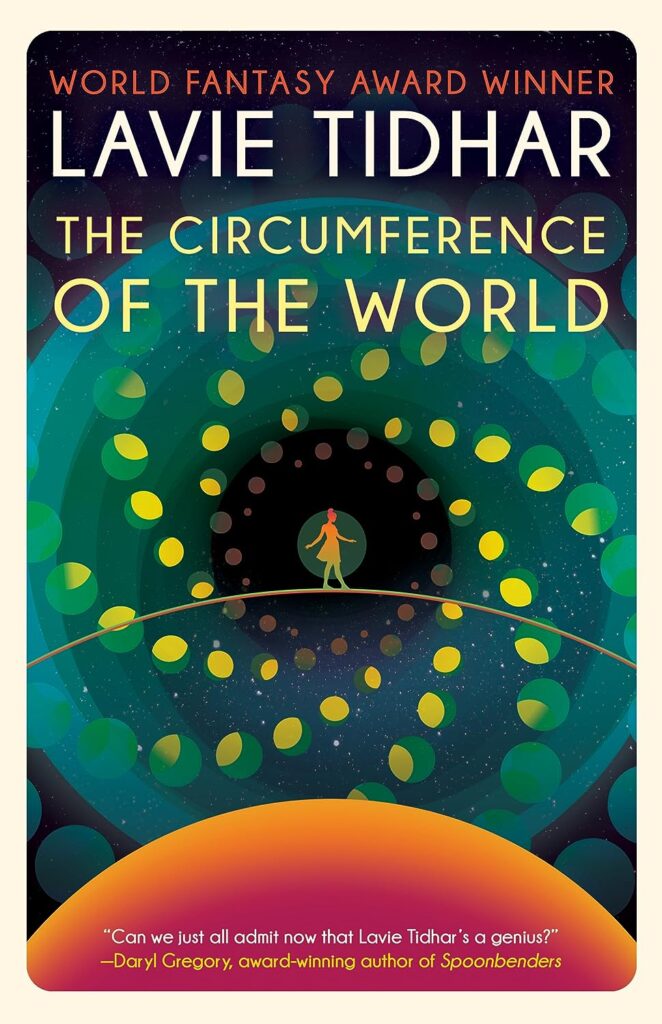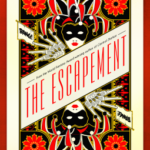The Circumference of the World by Lavie Tidhar is even grander in scope than its title at first suggests. Like many Tidhar novels, it is uniquely brilliant, but this one draws together in its luminous writing many perspectives that take some time to sort out. There is a young woman from Vanuatu, a mathematician in London, a face-blind bookseller, a Russian mobster with a transcendental streak, a science fiction writer, Eugene C. Hartley, modeled loosely on L. Ron Hubbard, and even an elusive figure speaking to us from the end of time. In the midst of it all is a scifi novel within the novel, supposedly written by Hartley in 1962, the existence of which is denied by most people.
There is so much about seeing, about light, about what is real, what is imagined, and about imagination itself in this book. Each character is a play on diverse forms of seeing or imagination. The novel takes us through six parts, each of which is dominated by a different character, yet they all cohere in an endless search for the meaning of the universe. It’s a short novel of about 240 pages, and, while each section is compelling in its own way, it may take a rereading to see how it fits together. Even then, in a book talking about ultimate realities, there is always going to be a mysterious element.
I’m going to summarize the major parts of the novel, so you may find that too spoilery. But there is something in the inner needs and searches of the characters that can’t be spoiled because they are so intense.
In the first section of the novel, we meet Delia Welegtabit and follow her from her childhood on Vanuatu to living in London with her mathematician husband. She is an albino, especially sensitive to light that travels from the far reaches of the universe to become vision within her mind. She is observed by a mysterious being “at the end of time” but after a point they cease to be able to see her because she stops being a hard fact defined by light and disappears into the realm of the imagined. And there Delia is in London with her husband Levi Armstrong, obsessed with Hartley’s book, Lode Stars (the very existence of which is disputed). One night Levi leaves Delia to focus on completing his theories and equations, she having become a distraction from his work. She calls Daniel Chase, a bookseller, to search for Levi, though he protests that he is not a detective.
Chase, suffering from prosopagnosia, cannot recognize faces but has been able to see Delia perfectly when she comes to him asking for help to find her husband. He reluctantly undertakes a search for Levi only to witness two faceless men force their way into his apartment and kidnap him. Daniel enters the apartment where police take him for an intruder and interrogate him. Ultimately, they turn him over to two thugs, also faceless to Daniel’s eyes, who take him to see Oskar Lens. Lens demands that Chase find the elusive book, Lode Stars, though he is sure this is an impossible mission.
Then we switch to Lens’ pov and follow his progress from Siberian labor camp prisoner to successful criminal who sets himself up in London. But he always feels hunted, pursued by mysterious beings called the eaters, and he yearns for a way to escape them forever. He develops a taste for science fiction and attends a fan club at a local pub where he meets Levi Armstrong, another driven man. They talk about Hartley and his book, and he becomes obsessed with the unreality of things and the lurking presence of the eaters.
Then the novel presents what appear to be fragments of the long-missing novel, Lode Stars by Eugene C. Hartley. It introduces us to another Delia, whom we find walking the circumference of the world. This world is a mesh of interlocking rings orbiting the Sun. It was constructed eons ago out of the planets of the solar system. Delia decides to travel ten thousand light years to find her dead father in the system known as the Lode Stars or the Eyes of God. He had left a cryptic note referring to his need to obtain a device known as an Occlude. Accompanied by her friend Ghis (a swarm of bees who can also assume human form), she constructs a starship for the journey and off they go, encountering along the way aliens of various religious orders. Mysteries abound as Delia approaches her destination, convinced that there is a new form of life to be found within God’s Eye.
From there, the novel switches to Hartley’s life, told partly by him in the first person, partly through the letters of famous literary figures of the 1950s who knew him. After a successful career as a pulp writer, he is driven to do more and creates a religion based on ideas in his fiction. Yet he can never escape a dread of mysterious creatures who are after him and becomes more and more isolated.
At every step of The Circumference of the World I was drawn into Tidhar’s brilliant writing, but with the shifts from one character to another, it is hard to follow any sort of emotional through line. Yet moment by moment, the feelings and actions of the characters are intense and compelling. What ties them together for me is the common search for an always elusive ultimate reality, a sense of certainty that can bring peace. This is a novel that stays with me, one with scenes and characters I keep going over in my mind. As unconventional as it is, The Circumference of the World has become one of my favorite Lavie Tidhar books, and that, for me, is high praise.





Leave a Reply